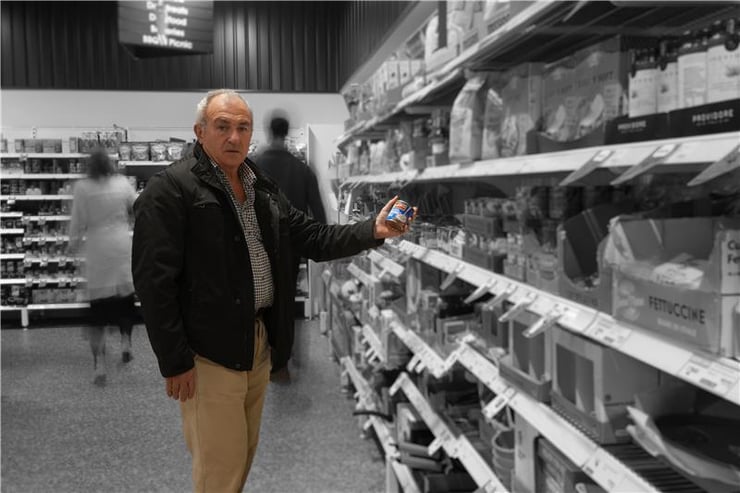For people with cognitive, sensory and physical impairments, a trip to the supermarket can be harder than you'd think...
You’ve probably never given your weekly dash to the supermarket much thought.
Beyond remembering what’s on our shopping lists (do we need carrots?), the mechanics of the process – getting through the shopping complex to the store, finding the right aisle for rice, even whether we’ve got the strength to walk as we push a trolley – never cross most of our minds.
But for people with cognitive, sensory and physical impairments (all common aspects of living with dementia), something as simple as a trip to the supermarket can turn into a very difficult and challenging task.
And it’s not just supermarkets – it’s cafés, doctor’s surgeries, libraries and banks. It’s concert halls and public toilets and airports. And any other public and retail space you care to name.
More than 800,000 people are expected to be living with dementia in Australia by 2050.
More than 800,000 people are expected to be living with dementia in Australia by 2050. Two thirds of people presently living with dementia elect to stay in their own homes, connected to their own communities.
Add them to the number of people with other causes of cognitive, sensory and physical impairment, and that’s an awful lot of people struggling to navigate our public and commercial environments, right now.
The good news is, there are ways to improve the situation.
Going to the shops with Bill
To elaborate on some of the challenges mentioned above, we went to the supermarket with Bill Yeates (pictured), who lives with dementia and works as a living experience consultant with The Dementia Centre.
Bill never thought much about shopping before his diagnosis in 2019. In his words, ‘I just grabbed the green basket and off I went.’
But that’s all changed. For Bill, the biggest obstacles to a successful supermarket visit are unhelpful signage and lack of education.

Unhelpful signage
From the moment Bill enters a shopping complex – with their often deliberately circuitous layouts and clamorous signage – he’s struggling. Just finding the supermarket can be torturous, but when he gets there, locating what he needs is sometimes next to impossible because the signs are placed too high (where people with cognitive impairment may not think to look) and the writing is too small.
Not only that – the shelving arrangements change regularly.
‘It's disastrous for me,’ Bill said. ‘I have a memory that if I go down to the second aisle, I'll find the cereal and then, all of a sudden, they change it. I'm completely lost.’
He believes the use of symbols rather than text would be a helpful fix, plus eye level signage (so even if things change, shoppers can keep up).
He believes the use of symbols rather than text would be a helpful fix, plus eye level signage (so even if things change, shoppers can keep up). A store tablet supplied at the information desk allowing item searches and their shelf positions, in large, clear font, could also assist.
He singles out small font as a problem in places other than the supermarkets, with café menus earning his particular ire.
‘The font is too small, and the meal names are too clever,’ he said. ‘I just want it to be simple. Pictures would be great.’
Lack of education
Bill is often reluctant to ask for help because he knows people don’t understand his condition.
‘It’s an invisible disability,’ he said. ‘And people are less helpful because they can’t see what’s wrong with me.’
‘It’s an invisible disability. And people are less helpful because they can’t see what’s wrong with me.’
He suggests large retailers could supply sunflower lanyards (as used at sporting and music events, and airports) or similar for use in the store, so staff can more easily identify people with hidden disabilities.
Also, training a key team member in supporting customers with impairments would mean that someone in the store might know how to help.
Other obstacles
Bill point out five other aspects of public and retail spaces that can make shopping more difficult:
- Poor contrast – bathrooms where everything is white mean people can’t navigate the space. Providing contrast between the toilet seat, wall and floor means the toilet can be seen.
- No rest points – people living with dementia (as well as many other people) need to stop frequently to rest. Seats incorporated into supermarket or shopping mall designs could help people shop confidently, knowing that they can rest when needed.
- Unfamiliar appliances – space-age bathroom taps or hidden lighting controls might be fashionable, but they make spaces unusable for thousands of people with hidden disabilities.
- Incorrect lighting – overly bright light sources, uneven lighting conditions or simply a lack of light may be disorienting. (A person living with dementia may require twice the typical light level.)
- Noise – loud music and announcements, hard surfaces and crowds can lead to confusion. Soft furnishings and carpet can mitigate this, as well as scheduled quiet times in larger shops and centres.
Taking a step towards better
Thoughtful interior and exterior design can help reduce confusion, minimise anxiety and foster a sense of security, enabling individuals with dementia to visit the pharmacy, grab some groceries and relax with a cup of coffee, just like everyone else. This means they can live at home for longer.
Find out more about how your spaces can start making sense for the growing number of people living with dementia.
And if your business or organisation is looking to support customers with dementia-informed team members, we can help with that, too.